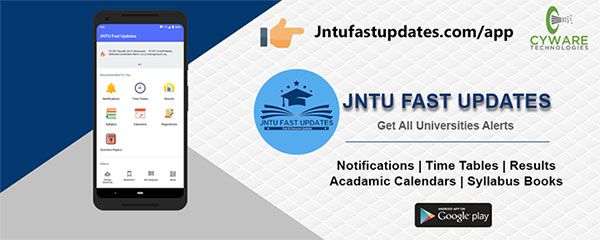JNTUK R16 3-1 DICA Material/Notes PDF Download
Students those who are studying JNTUK R16 ECE Branch, Can Download Unit wise R16 3-1 Digital IC Applications Material/Notes PDFs below.

JNTUK R16 3-1 DICA Material/Notes PDF Download
OBJECTIVES:
- Introduction of digital logic families and interfacing concepts for digital design is considered.
- VHDL fundamentals were discussed to modeling the digital system design blocks.
- VHDL compilers, simulators and synthesis tools are described, which are used to verify digital systems in a technology-independent fashion.
- Design and implementation of combinational and sequential digital logic circuits is explained.
UNIT-1
Digital Logic Families and Interfacing: Introduction to logic families, CMOS logic, CMOS steady state and dynamic electrical behavior, CMOS logic families. Bipolar logic, transistor-transistor logic, TTL families, CMOS/TTL interfacing, low voltage CMOS logic and interfacing, Emitter coupled logic. (Text book-1)
UNIT-2
Introduction to VHDL: Design flow, program structure, levels of abstraction, Elements of VHDL: Data types, data objects, operators and identifiers. Packages, Libraries and Bindings, Subprograms. VHDL Programming using structural and data flow modeling. (Text book-2)
UNIT-3
Behavioral Modeling: Process statement, variable assignment statement, signal assignment statement, wait statement , if statement, case statement ,null statement, loop statement, exit statement, next statement ,assertion statement, more on signal assignment statement ,Inertial Delay Model, Transport Delay Model ,Creating Signal Waveforms, Signal Drivers , Other Sequential Statements , Multiple Processes. Logic Synthesis, Inside a logic Synthesizer. (Text book-2)
UNIT-4
Combinational Logic Design: Binary Adder-Subtractor, Ripple Adder, Look Ahead Carry Generator, ALU, Decoders, encoders, multiplexers and demultiplexers, parity circuits, comparators, Barrel Shifter, Simple FloatingPoint Encoder, Dual Priority Encoder, Design considerations of the above combinational logic circuits with relevant Digital ICs, modeling of above ICs using VHDL. (Text book-1)
UNIT-5
Sequential Logic Design: SSI Latches and flip flops, Ring Counter, Johnson Counter, Design of Modulus N Synchronous Counters, Shift Registers, Universal Shift Registers, Design considerations of the above sequential logic circuits with relevant Digital ICs, modeling of above ICs using VHDL. (Text book-1)
UNIT-6
Synchronous and Asynchronous Sequential Circuits: Basic design steps: State diagram, state table, state assignment, choice of flip flops and derivation of next state and output expressions, timing diagram. State assignment problem: One hot encoding. Mealy and Moore type FSM for serial adder, VHDL code for the serial adder. Analysis of Asynchronous circuits, State Reduction, State Assignment. A complete design example: The vending machine controller. (Reference text book- 1)
TEXT BOOKS:
Digital Design Principles & Practices – John F. Wakerly, PHI/ Pearson Education Asia, 3rd Ed., 2005.
- VHDL Primer – J. Bhasker, Pearson Education/ PHI, 3rd Edition.
REFERENCE BOOKS:
- Fundamentals of Digital Logic with VHDL Design- Stephen Brown, ZvonkoVranesic, McGrawHill, 3rd
Edition.
OUTCOMES:
- Understand the structure of commercially available digital integrated circuit families.
- Learn the IEEE Standard 1076 Hardware Description Language (VHDL).
- Model complex digital systems at several levels of abstractions, behavioral, structural, simulation, synthesis and rapid system prototyping.
- Analyze and design basic digital circuits with combinatorial and sequential logic circuits using VHDL.

320-x100(1).gif)

MCA results evakonda a sodi anti